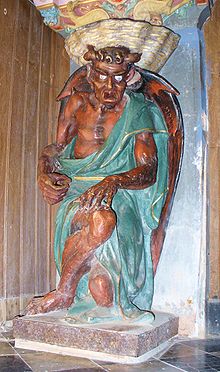This article has multiple issues.Please helpimprove itor discuss these issues on thetalk page.(Learn how and when to remove these messages)
|
In someoccultand similar writings, anarchdemon(also spelledarchdaemon),archdevil,orarchfiendis a spiritual entity prominent in theinfernalhierarchy as a leader ofdemons.[1]Essentially, the archdemons are the evil opponents of thearchangels.

Christian traditions
editArchdemons are described as the leaders of demonic hosts, just as archangels leadchoirs of angels.Based upon the writings ofSaint Paul(Col. 1:16; Eph. 1:21) the angelic court had been constructed byPseudo-Dionysius the Areopagiteand comprised nine orders of angels with three orders each to three hierarchies.
The first hierarchy consists ofseraphim,cherubimandthrones.The second hierarchy consists ofdominations,virtuesandpowers.The third hierarchy consists ofprincipalities,archangelsandangels.This system of classifying angels has been accepted by the majority of Christian scholars. However, no similar consensus has been reached on the classification of demons.This is largely due to the fact that, historically, the definition of what an archdemon is and the names of those demons has varied greatly over time.
One common medieval classification associate theseven deadly sinswith archdemons:[2]
- Lucifer:Pride
- Mammon:Greed
- Asmodeus:Lust
- Leviathan:Envy
- Beelzebub:Gluttony
- Satan:Wrath
- Belphegor:Sloth[3]
In theocculttradition, there is controversy regarding which demons should be classed as archdemons. During different ages, some demons were historically "promoted" to archdemons, others were completely forgotten, and new ones were created. In ancientJewishlore, many of thepagangods of neighboring cultures were identified as extremely pernicious demons in order to prevent Jews from worshiping them.
Therefore, the pagan deityBa'alwas reinterpreted as the archdemonBaelorBeelzebub,and the pagan deityAstartewas reinterpreted as the archdemonAstaroth.These two in particular were seen as some of the worst enemies ofGod.By the Middle Ages, these pagan deities were no longer worshiped, so their characterizations as archdemons were no longer important, but they still persisted anyway. New archdemons were invented over time, most of them revolving aroundSatanand theAntichrist.
Islamic tradition
editAccording to Middle Eastern Folkmagic usually, seven kings of the jinn are assigned to each day of the week. Although they can do, unlike thespirits of heavens,both good and evil, they have responsibility given byGodregarding the affairs of the earth. In some reports, they are ratherinfernal demons(ʻIfrīt) than explicitlyjinn.AhadithfromWahb ibn Munabbihreports that the archetypes of the jinn are like air, differing from the regular jinn, they don't need to eat, drink and they do not produce offspring.[4]Since they do not move themselves, they send subordinate devils (shayāṭīn). They are mentioned in several Muslim treatises, such as theBook of Wonders.
TheMuslim occultistAhmad al-Bunisets four of these kings namedMudhib,Maimun,Barqanandal-Ahmar,in opposition to the fourarchangelsofIslam.[5]They frequently appear inscribed intalismans.According to Muslim astrology, one needs to get permission of the king of the jinn for the corresponding day to perform a spell. When the jinn-king is summoned together with the name of the angel responsible for the day, it would be impossible for the jinn-king to deny an order of the sorcerer.[6]
According toMas'udi's "Annals of Time", four Afarit carry the throne ofIblis,analogue to theHamlat al Arshcarrying the throne of God.[7]
Middle Eastern tales
editIn some Middle Eastern legends, an order ofnineteen angels of hellexists, each commanding a host of devils. Among them is the Quranic guardian of hell-fireMaalik.Another Quranic member is thefallen angelIblis,who is also their leader. However, most individual members are not based on the Quran, but integrated toMuslim understanding of sin.One member of the infernal council is responsible for distracting during prayer, one advocatesillicit innovations in religious affairs,yet another one inciteslust(etc.). These devils are not thought to fulfill the requests of a sorcerer, but serve as means of punishment in the hereafter or as adversaries of the prophetSolomon.According to the corresponding legend, both Solomon and the arch-devils struggle for their reign over thejinnanddiv.[8]
Zoroastrianism
editAccording toZoroastriandualism,the world is created by two opposing forces. ThegooddeityAhura Mazdacreated everything good, but for everything good createdAhrimancreated an evil opposite. These results in the existence of seven Archdemons, who in return command a countless numbers ofdemons.These archdemons stay in exact opposition to theAmesha Spenta.[9]
Demon Kings of theArs Goetia
editThe Lesser Key of Solomon,an anonymous 17th century grimoire, lists 72 of the most powerful and prominent demons of Hell in its first part, theArs Goetia.Satan himself is not mentioned among them considering his overall dominion of Hell as thePrince of Darkness.Below him, theArs Goetiasuggests, are the four kings of the cardinal directions who have power over the seventy-two, next the kings, and onward with other demons with lower monarchic titles. The four kings of the cardinal directions are the primary point of contention between different editions and translations, and occultist writers. The common composition of the kings is:
References
edit- ^Theresa Bane, Encyclopedia of Demons, 2010
- ^Encyclopædia BritannicaThe New Encyclopædia Britannica: Macropædia1991ISBN978-0-852-29529-8page 411
- ^Encyclopedia of Demons and Demonology, By Rosemary Guiley, p. 28-29, Facts on File, 2009.
- ^Sharpe, Elizabeth MariInto the realm of smokeless fire: (Qur'an 55:14): A critical translation of al-Damiri's article on the jinn from "Hayat al-Hayawan al-Kubra"The University of Arizona 1953
- ^Robert LeblingRobert LeblingI.B.Tauris 2010ISBN978-0-857-73063-3page 86-87
- ^Mommersteeg, Geert. “‘He Has Smitten Her to the Heart with Love’ The Fabrication of an Islamic Love-Amulet in West Africa.” Anthropos, vol. 83, no. 4/6, 1988, pp. 501–510. JSTOR, jstor.org/stable/40463380. Accessed 13 June 2020.
- ^el-Zein, A. (1995). The evolution of the concept of the Jinn from pre-Islam to Islam. p.190
- ^Joseph Hammer Purgstall; Rosenöl. 971 original: 1813 Georg Olms Verlag. pp. 184, 320
- ^S. A. Nigosian, Solomon Alexander Nigosian The Zoroastrian Faith: Tradition and Modern ResearchMcGill-Queen's Press 1993ISBN9780773511446p.86
Works cited
edit- Bane, Theresa (2010),Encyclopedia of Demons in World Religions and Cultures,MacFarland,ISBN978-0-7864-6360-2
Further reading
edit- Robbins, Rossell (1959),The Encyclopedia of Witchcraft and Demonology,Crown Publishers Inc.,ISBN0-600-01183-6